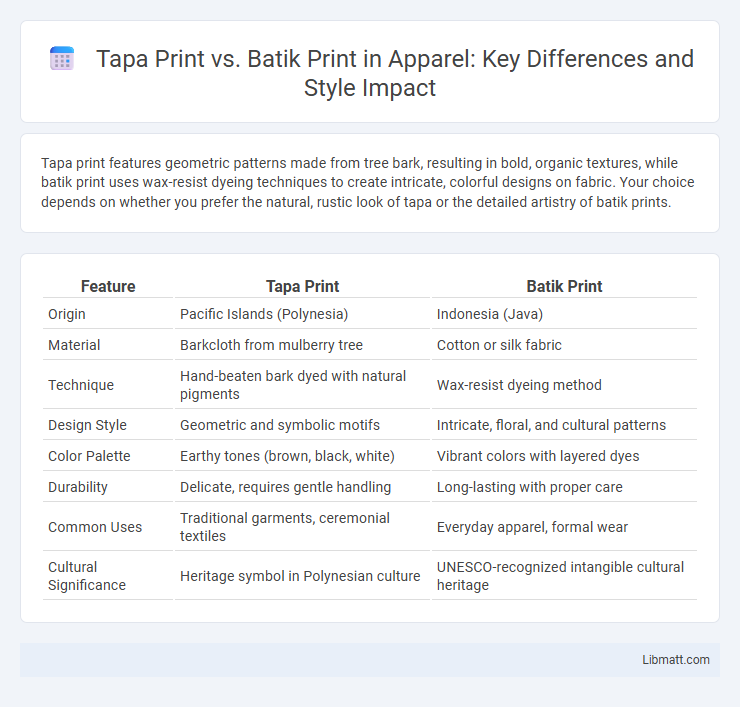Tapa print features geometric patterns made from tree bark, resulting in bold, organic textures, while batik print uses wax-resist dyeing techniques to create intricate, colorful designs on fabric. Your choice depends on whether you prefer the natural, rustic look of tapa or the detailed artistry of batik prints.
Table of Comparison
| Feature | Tapa Print | Batik Print |
|---|---|---|
| Origin | Pacific Islands (Polynesia) | Indonesia (Java) |
| Material | Barkcloth from mulberry tree | Cotton or silk fabric |
| Technique | Hand-beaten bark dyed with natural pigments | Wax-resist dyeing method |
| Design Style | Geometric and symbolic motifs | Intricate, floral, and cultural patterns |
| Color Palette | Earthy tones (brown, black, white) | Vibrant colors with layered dyes |
| Durability | Delicate, requires gentle handling | Long-lasting with proper care |
| Common Uses | Traditional garments, ceremonial textiles | Everyday apparel, formal wear |
| Cultural Significance | Heritage symbol in Polynesian culture | UNESCO-recognized intangible cultural heritage |
Introduction to Tapa Print and Batik Print
Tapa print originates from the Pacific Islands, created by pounding and dyeing mulberry bark to produce unique patterns, often symbolizing cultural stories and traditions. Batik print, rooted in Indonesia, involves applying wax resist to cloth before dyeing, resulting in intricate and detailed designs with vibrant color contrasts. Both techniques represent rich artisanal heritage but differ significantly in materials, methods, and regional significance.
Historical Origins of Tapa Print and Batik Print
Tapa print originates from the Polynesian islands, where it is traditionally made from the bark of the paper mulberry tree and decorated with patterns representing social status and cultural stories. Batik print, on the other hand, traces its roots to Indonesia, utilizing a wax-resist dyeing technique that creates intricate designs symbolizing heritage and regional identity. Understanding these historical origins enriches your appreciation of each textile's cultural significance and artistic value.
Cultural Significance in Different Regions
Tapa print holds deep cultural significance in Pacific Island countries such as Fiji, Tonga, and Samoa, symbolizing ancestral heritage and traditional ceremonies through intricate, hand-beaten bark fabric designs. Batik print, originating from Indonesia, is renowned for its wax-resist dyeing technique and serves as a vital expression of Javanese cultural identity, often used in rituals, weddings, and royal attire. Both prints embody unique regional histories and artistry, reflecting social values and spiritual beliefs distinctive to their respective communities.
Materials Used in Tapa and Batik Printing
Tapa print uses the inner bark of trees, primarily from mulberry, breadfruit, or fig trees, which is soaked and beaten into thin sheets before printing. Batik print involves applying wax-resistant dye on cotton or silk fabrics to create intricate patterns, relying on natural or synthetic wax and textile dyes. Understanding these distinct materials helps you appreciate the unique textures and traditional crafting techniques of each art form.
Traditional Techniques and Methods
Tapa print involves creating patterns on bark cloth using natural dyes derived from plants, with designs often stamped or hand-painted to reflect Pacific Islander heritage. Batik print employs a wax-resist dyeing technique, where hot wax is applied to fabric to create intricate motifs before dyeing, a method rooted in Indonesian culture. Your choice between these traditional techniques depends on the desired texture and cultural significance you want to showcase in your textile projects.
Visual Differences: Patterns and Designs
Tapa print typically features bold, repetitive geometric patterns inspired by Polynesian and Melanesian art, characterized by earthy tones and natural motifs such as leaves, bark, and tribal symbols. Batik print is known for its intricate, detailed designs with fluid lines and vibrant colors, often illustrating floral, animal, or cultural scenes through wax-resist dyeing techniques. The visual contrast lies in tapa's more rustic, symmetrical patterns versus batik's elaborate, colorful, and often asymmetrical artistry.
Symbolism and Artistic Expression
Tapa print and batik print both serve as rich mediums for symbolism and artistic expression yet differ culturally and stylistically. Tapa print, rooted in Polynesian traditions, uses intricate geometric patterns that symbolize ancestry, social status, and spiritual beliefs. Batik print, originating from Indonesia, expresses complex narratives through wax-resist techniques illustrating folklore, natural elements, and philosophical themes, making each piece a unique artistic statement.
Modern Adaptations and Innovations
Tapa print and batik print have undergone significant modern adaptations, blending traditional craftsmanship with contemporary design techniques. Digital printing technologies enable intricate tapa patterns on diverse fabrics, enhancing versatility and market appeal, while innovations in wax-resist methods have allowed batik prints to incorporate vibrant colors and faster production. Your ability to choose between these prints depends on appreciating how their evolving techniques preserve cultural heritage while meeting modern fashion demands.
Sustainability and Environmental Impact
Tapa print and batik print differ significantly in sustainability and environmental impact, with tapa print typically using natural bark cloth and plant-based dyes that are biodegradable and less chemically intensive. Batik print often involves wax-resist dyeing, which can generate chemical waste and requires careful management to minimize environmental harm. Choosing tapa print supports sustainable practices by reducing reliance on synthetic materials and promoting eco-friendly dyeing techniques, making it a greener option for your textile needs.
Choosing Between Tapa Print and Batik Print
Choosing between tapa print and batik print depends on your preference for cultural significance and design complexity. Tapa print, originating from Polynesian cultures, features bold, natural motifs created using bark cloth, while batik print, rooted in Indonesian tradition, showcases intricate patterns made with wax-resist dyeing techniques. Your decision should consider the uniqueness of tapa's organic textures versus batik's detailed craftsmanship to best suit your style or project needs.
tapa print vs batik print Infographic

 libmatt.com
libmatt.com